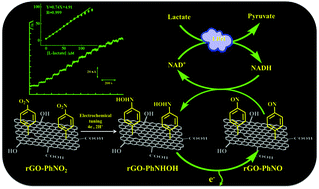Covalent functionalization and electrochemical tuning of reduced graphene oxide for the bioelectrocatalytic sensing of serum lactate†‡
Abstract
Lactate is a byproduct of glycolysis and serum lactate can be used as a non-invasive biomarker in risk-stratifying patients with several life-threatening diseases. Herein, we describe the bioelectrocatalytic sensing of lactate using a covalently functionalized reduced graphene oxide (rGO)-based material. The development of a lactate biosensor involves the covalent functionalization of rGO with the p-nitrophenyl moiety, electrochemical generation of a surface-confined redox mediator and immobilization of L-lactate dehydrogenase (LDH). The covalently functionalized rGO was characterized by XRD, XPS, FTIR, Raman, resistivity and electrochemical measurements. The covalent attachment of the nitrophenyl moiety on the basal plane of the carbon network significantly influences the capacitive properties of rGO. The chemically functionalized rGO was electrochemically tuned to generate a redox mediator (rGO-PhNHOH). An electrochemically generated redox couple (PhNHOH/PhNO) exhibits reversible voltammetric response at ∼−0.06 V with a surface coverage of (7.19 ± 0.26) × 10−9 mol cm−2. The redox couple efficiently mediates the oxidation of NADH at 0.04 V, which is ∼600 mV less positive potential than the unmodified electrode. The electrode is highly sensitive towards NADH and it could detect as low as 0.4 μM NADH at the potential of 40 mV at neutral pH without any interference from co-existing bioanalytes. A lactate biosensor was developed using the rGO-PhNHOH functional material and lactate dehydrogenase. The surface-confined redox mediator could successfully detect the enzymatically generated NADH at 40 mV. The biosensor is highly sensitive (10.57 ± 0.38 nA μM−1 cm−2) and shows linear response up to 90 μM of lactate. It could detect lactate as low as 2.5 μM without any interference from other analytes. This biosensor has been successfully used to quantify human serum lactate and the results are in excellent agreement with those obtained by the clinical method.


 Please wait while we load your content...
Please wait while we load your content...